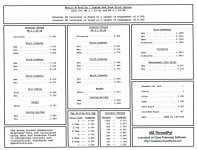Hi Guys,
we are having trouble with convincing our supplier that our rejections for screws and nuts are valid.
basically we are using calibrated Thread Calipers as our main inspection instrument. However, when the same rejected screws are checked on a calibrated caliper at supplier, they are OK. My questions are as below:
what is the best/most thorough method of measuring screws out of below?
a. External Thread Caliper gauge,
b. Thread Parallels contacts (we currently don’t have thread micrometers),
c. Thread Pitch gauge
d. Go/NoGo Ring Thread gauge
Also for nuts we are using calibrated Go/NoGo plug gauge but even then it is not a valid rejection as per supplier.
How can we justify our inspections and convince supplier that our rejections are valid?
Regards,
Mustafa
we are having trouble with convincing our supplier that our rejections for screws and nuts are valid.
basically we are using calibrated Thread Calipers as our main inspection instrument. However, when the same rejected screws are checked on a calibrated caliper at supplier, they are OK. My questions are as below:
what is the best/most thorough method of measuring screws out of below?
a. External Thread Caliper gauge,
b. Thread Parallels contacts (we currently don’t have thread micrometers),
c. Thread Pitch gauge
d. Go/NoGo Ring Thread gauge
Also for nuts we are using calibrated Go/NoGo plug gauge but even then it is not a valid rejection as per supplier.
How can we justify our inspections and convince supplier that our rejections are valid?
Regards,
Mustafa


 I doubt particulates are the problem, but you get the idea, just because two gauges meet "a standard" really doesn't mean much.
I doubt particulates are the problem, but you get the idea, just because two gauges meet "a standard" really doesn't mean much.
